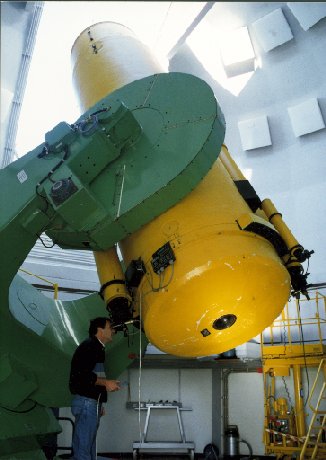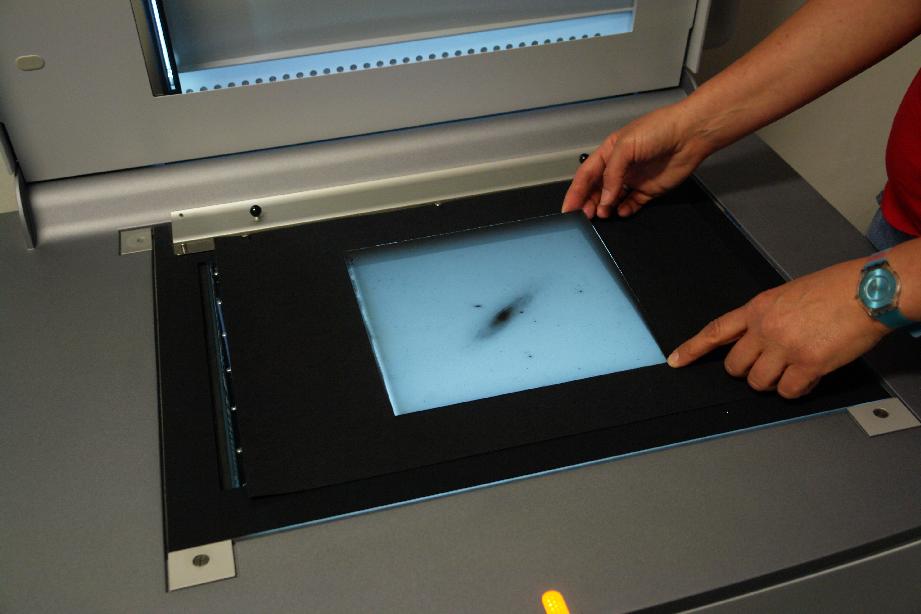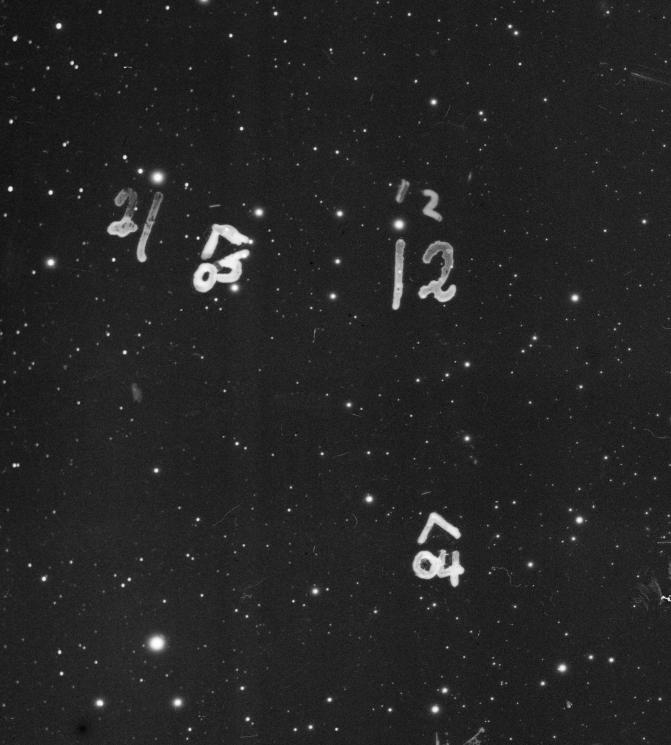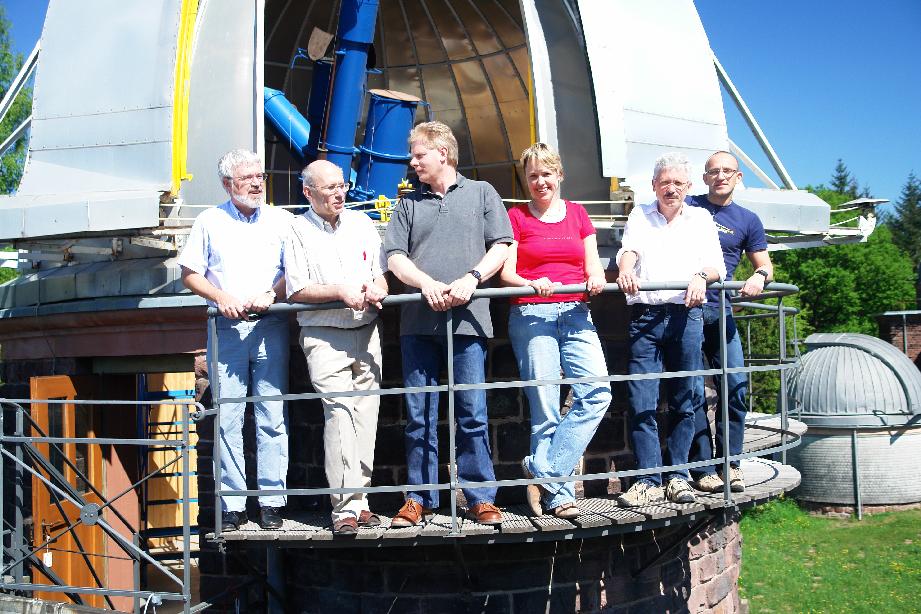Digitizing Astronomical Plates of the Heidelberg Königstuhl Archives
Joachim Krautter(1), Reinhard Mundt(2), Kurt Birkle(1,2), M. Demleitner(3), André Germeroth(1), Gerhard Klare(1), Gabriella Langer(1), Holger Mandel(1), Peter Schwekendiek(3), Lukas Siegwald(1), Otmar Stahl(1)
- Zentrum für Astronomie Heidelberg (ZAH), Landessternwarte
- Max-Planck-Institut für Astronomie Heidelberg
- Zentrum für Astronomie Heidelberg (ZAH), Astronomisches Rechen-Institut
The project
At the Landessternwarte (LSW) Heidelberg-Königstuhl, since Jan. 1st 2005 a section of the Zentrum für Astronomie of the University of Heidelberg, a joint project has been started in October 2005 to digitize the photographic plates of the archives of the LSW and of the Max-Planck-Institut für Astronomie (MPIA) Heidelberg. In a first high priority run, only those wide-field plates are scanned which were taken with siderial guiding on the Bruce double astrograph of the LSW and on the Schmidt telescope of the MPIA at Calar Alto Observatory (Figures 1 and 2, Tables 1 and 2). In this way, several 1000 astronomical plates out of a total of about 10,000 historical Bruce plates and of about 600 Schmidt plates, with limiting magnitudes of up to 18 mag and 21 mag, respectively, will be made available via Internet to the astronomical community. For this purpose, the digitized data are stored as part of the GAVO data base (German Astronomical Virtual Observatory) which is installed in the Astronomisches Rechen-Institut (ARI), Heidelberg.
| Telescope | Aperture (cm) | Focal length (cm) | Guiding telescope (cm) | Site (IAU Code) | Longitude Latitude Altitude |
|---|---|---|---|---|---|
| Bruce Double- Astrograph | objective A: 40 objective B: 40 (2 plates simultaneously) | 200 200 (f/5) | f = 400 f/16 | Heidelberg Königstuhl (24) | 08°43′15″E 49°23′55″N 560m |
| Schmidt | corr. plate: 80 mirror: 120 | 240 (f/3) | 2 x f = 300 f/15 autoguider | Calar Alto Prov. Almeria Spain (493) | -02°32′15″W 37°13′27″N 2160m |
In a later phase, this project might be extended to the other plates of these archives, guided on minor planets and comets, and also to plates taken on the 76-cm Waltz reflector of the LSW and on the 1.2-m, 2.2-m, and 3.5-m telescopes of the MPIA.
The Archives at Heidelberg-Königstuhl
Fig. 3: The Nexscan F 4100 scanner being loaded with a 8 x 10 inch Schmidt plate. The scanner window (315 x 457 mm full size) is masked leaving free only the plate size.
The Bruce archive of the LSW is containing about 10,000 plates, starting in August 1900 and covering 90 years, mainly of 24 cm x 30 cm size (Table 2). Most of them were taken by pairs nearly simulatenously on both identical refractors (Table 1) for clear identification of emulsion failures or other artefacts on the plates. Great part of the Bruce astrophotography was dedicated to minor planet research. No colour filters were used with the blue sensitive plates. The MPIA Schmidt telescope at Calar Alto Observatory, formerly at the Hamburger Sternwarte in Bergedorf, was mainly used for the Hamburg Quasar Survey from 1982 on. The plates of this project are archived by the Hamburg Observatory. In addition, about 600 Schmidt plates from other programs as well as from target of opportunity observations were collected in the MPIA archive. The mainly used emulsion/filter combinations are shown in Table 2. Due to the decline of plate production in the 1990 years, sometimes 8 x 10 inch films, including Ektachrome for direct colour photography, were used with a modified plate holder for the spherically bent films.
| Telescope | Plate scale (arcsec/mm) | Pixel size (μm) (arcsec) | Plate size (cm; inch) | Field size (degree) | File size (GByte) | Colours Emulsions |
|---|---|---|---|---|---|---|
| Bruce Double- Astrograph | 103 | 10 x 10 1.03 x 1.03 | 24 x 30 30 x 30 | 6.6 x 8.2 8.2 x 8.2 | 1.3 | B, m(pg) blue sensitive |
| Schmidt | 86 | 10 x 10 0.86 x 0.86 | 24 x 24 8″ x 10″ | 5.5 x 5.5 4.6 x 5.8 | 1.0 0.9 | B, V, R Kodak IIIaJ, IIIaF Techpan, Ektachrome |
The Scanning Program
Fig. 4: Part of the scanned Bruce plate No. B2229 showing the Minor Planets (325) Heidelberga (label 05) and (175) Andromache (label 04); exposure date: January 27, 1909, 210 minutes; field size: 90 armin x 100 arcmin; north is up, east to the left.
In the first part of our digitizing project, more than 5000 Bruce and about 250 Schmidt plates will be scanned which were taken with siderial guiding, leaving aside for a (possibly) second project phasephotographs of minor planets and comets guided according to their apparent motion, hence containing star trails. Up to now, about 3000 Bruce and about 230 Schmidt plates are scanned. In most cases, depending on plate quality, both plates of a Bruce pair are scanned; for objects close to the plate limit superposition of the digitized pair might be useful.
Fig. 5: Example of a scanned Schmidt plate with a 54.6 arcmin x 58.5 arcmin section of the Pleiades: Plate No. A 470 is a 60 min exposure on IIIaJ behind a GG385 Schott filter; north is up, east to the left.
A Nexscan F4100 professional scanner of the Heidelberger Druckmaschinen AG (hardware and software) is used. This instrument has a 315 mm x 457 mm scan area which is masked down to our various plate sizes; it is equipped with a 3 x 8000 pixel CCD array for colour (RGB) and black and white work. In the BW-mode the 3 colour channels are averaged maintaining the 16 bit/pixel dynamical range! The maximum resolvable density is D = 4. The real optical resolution of the scanner is 5080 dpi; internal interpolation (up to 10.800 dpi) as well as other scanner features like e.g. "sharpening" or nonlinear transparency curves are not applied in our work.
Fig. 6: Enlargement of the central 106 x 60 pixels (91 arcsec x 52 arcsec) of Fig. 5. The 5 stellar images, from east to west, have the following B magnitudes in the USNO-B1 catalogue: 18.2, 20.3, 19.5, 20.1, and 19.9, respectively. The sky background (nebulosity around Merope) is at 22.460 +/- 1.185 counts, the centers of the two eastern stellar images have 59.470 and 34.170 counts, respectively.
For the Bruce and Schmidt plates we selected 2540 dpi corresponding to 10 μm x 10 μm pixel size (Table 2). This value is a compromise between photographic resolution (granularity of the emulsions) and size of the files of more than 1 GByte per plate. Figures 4 and 5 give examples for such scans. The importance of a relatively high scanning resolution, essential for good astrometric and photometric work, is shown by Figure 6; the information content of the plate is made visible to a high degree: even for faint stellar images their diameter is distributed over several pixels (seeing was 1 arcsec), and fine details, like e.g. a slight east-west image elongation due to slightly imperfect guiding, are remaining visible.
The HDAP database
Fig. 7: Some members of the scanner group in front of the historical Bruce telescope: J. Krautter, K. Birkle, H. Mandel, G. Langer, O. Stahl, L. Siegwald (from left to right).
A database of the scanned plates has been established under the name HDAP - Heidelberg Digitized Astronomical Plates. Each plate entry with the essential observing and plate data is supplemented by the parameters of the astrometric plate solution. Most data of each entry also appears in the FITS header of a scan. For easy handling of the large files, it is possible to cut a small field out of the whole plate, its FITS header containing then just the right astrometric data of that field. Apart from the plate catalogue, the installation of the data base is still at the beginning. Nevertheless, several photometric and astrometric investigations at various institutes make already use of some of the scans available as yet. Requests for plate data are welcome at any time before completion of the data base.
Acknowledgement
The financial support of the project by the Klaus-Tschira Foundation, Heidelberg under contract No. 00.071.2005 is highly appreciated.






